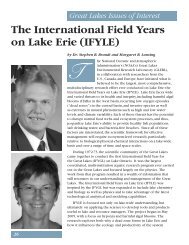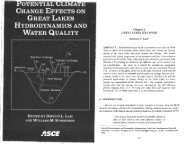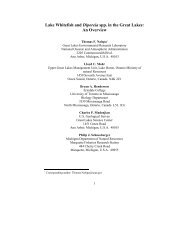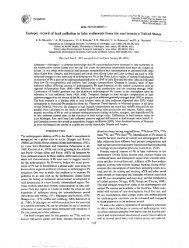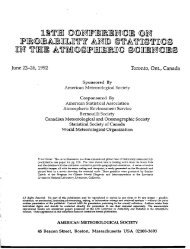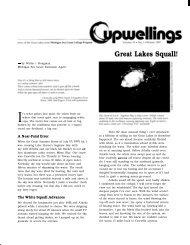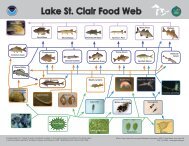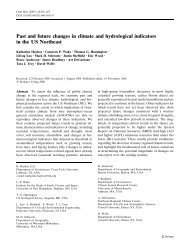Phosphorus limitation and diel control of nitrogen-fixing ...
Phosphorus limitation and diel control of nitrogen-fixing ...
Phosphorus limitation and diel control of nitrogen-fixing ...
Create successful ePaper yourself
Turn your PDF publications into a flip-book with our unique Google optimized e-Paper software.
42<br />
Mar Ecol Prog Ser 345: 41–50, 2007<br />
are closely linked with bottom-water redox conditions<br />
(Kiirikki et al. 2001). Over long periods <strong>of</strong> stagnation,<br />
oxygen in waters beneath the Baltic Sea halocline is<br />
consumed <strong>and</strong> anoxia develops (Nehring 1981). Under<br />
anoxic conditions, phosphate <strong>and</strong> ammonia are<br />
released, while in hypoxic waters <strong>and</strong> sediments,<br />
denitrification is promoted (Kuparinen & Tuominen<br />
2001). Both <strong>of</strong> these processes promote reductions in<br />
the N:P ratio in dissolved nutrients in the bottom<br />
waters. Baltic Sea bottom-water exchange is dependent<br />
on frequency <strong>of</strong> storms that force salty oceanic<br />
water over the sills at the Danish Sounds to the Baltic<br />
Sea from the North Sea. As this salty water oxygenates<br />
the Baltic Sea bottom, some <strong>of</strong> the lower salinity, low<br />
N:P ratio, P-enriched anoxic bottom waters are transported<br />
to the surface (Nehring 1981) <strong>and</strong>, as a result,<br />
intense cyanobacterial blooms develop over the next<br />
several years (Kahru et al. 2000, Kiirikki et al. 2001).<br />
Superimposed on this large-scale forcing cycle,<br />
which has significant interannual variability in the<br />
Baltic Sea, P effects on growth <strong>and</strong> N 2 fixation <strong>of</strong><br />
cyanobacteria are observed regionally <strong>and</strong> locally, at<br />
short time scales. Certain Baltic Sea regions are hydrodynamically<br />
more active than others, <strong>and</strong> susceptible<br />
to vertical water exchange such as upwelling <strong>and</strong><br />
frontal transport that act as ‘P pumps’ into the surface<br />
waters (Kononen et al. 1996, Pavelson et al. 1997,<br />
Vahtera et al. 2005). These locations are <strong>of</strong>ten sites <strong>of</strong><br />
intensive cyanobacterial growth. Cyanobacterial populations<br />
in the euphotic surface waters are likely to<br />
experience P depletion repeatedly over the growing<br />
season, depending on hydrodynamic conditions <strong>and</strong><br />
how far they have advected from these P ‘hotspots’. P<br />
regeneration within Nodularia spumigena aggregates<br />
may be an important mechanism by which blooms are<br />
maintained (Hagström et al. 2001). There is a general<br />
agreement that P regulates cyanobacterial bloom<br />
intensities in the Baltic Sea over interannual, basinwide<br />
scales (Kahru et al. 2000, Kiirikki et al. 2001).<br />
However, estimates on the regulation <strong>and</strong> <strong>limitation</strong> <strong>of</strong><br />
cyanobacterial growth <strong>and</strong> N 2 fixation in the Baltic Sea<br />
vary over time scales <strong>of</strong> hours to days (Wallström et al.<br />
1992, Stal et al. 1999, Rydin et al. 2002, Mois<strong>and</strong>er et<br />
al. 2003).<br />
The goal <strong>of</strong> this study was to investigate short-term<br />
effects <strong>of</strong> P on the growth <strong>and</strong> N 2 fixation <strong>of</strong> Baltic Sea<br />
cyanobacteria, to better underst<strong>and</strong> regional differences<br />
in bloom intensities <strong>and</strong> mechanisms for bloom<br />
maintenance. In order to study regulation <strong>of</strong> the <strong>nitrogen</strong>ase<br />
proteins over the <strong>diel</strong> cycle, we additionally<br />
investigated potential changes in the quantity <strong>and</strong> size<br />
<strong>of</strong> the 2 c<strong>of</strong>actors <strong>of</strong> the <strong>nitrogen</strong>ase enzyme (Fe <strong>and</strong><br />
MoFe proteins) in response to darkness. This information<br />
is essential for predicting <strong>and</strong> modeling cyanobacterial<br />
bloom formation <strong>and</strong> N 2 fixation based on<br />
P availability in the Baltic Sea.<br />
MATERIALS AND METHODS<br />
Baltic Sea field studies. Field studies were carried<br />
out onboard RV ‘Ar<strong>and</strong>a’ (Finnish Institute <strong>of</strong> Marine<br />
Research) in 2002 <strong>and</strong> 2003. The study area was<br />
located in the Gulf <strong>of</strong> Finl<strong>and</strong> <strong>and</strong> the Northern Baltic<br />
Proper (Table 1). Diel cycles in the field were studied<br />
through incubation experiments on deck using Baltic<br />
seawater (Expts 02A, 02B, 03A, 03B), <strong>and</strong> by sampling<br />
directly from the sea (Expt An03), both types <strong>of</strong><br />
samples defined as ‘field samples’ (Table 1). In the<br />
incubation experiments, surface water was collected<br />
from ~1 m depth using a pump (in 2002), or a 30 l water<br />
sampler (2003). All <strong>of</strong> the water collected was mixed in<br />
a 100 l container on deck, <strong>and</strong> then 14 l (2002) or 17 l<br />
(2003) were poured into each <strong>of</strong> six 20 l pre-cleaned<br />
(0.01 N HCl <strong>and</strong> deionized water) Cubitainers<br />
(Hedwin). Cubitainers are containers made <strong>of</strong> polyethylene<br />
<strong>and</strong> are approximately 85% transparent to incident<br />
photosynthetically active irradiation (PAR). The<br />
Table 1. Diel experiments with natural communities in the Baltic Sea. Temperature, salinity, <strong>and</strong> nutrients are from 1.5 to 2 m depth<br />
Expt Date Type Station Location Treatment Temp. Salinity DIN DIP<br />
or depth (°C) (µM) (µM)<br />
02A Sampled 15 July 2002 Cubitainer H02_A1_4 59.2946° N, Control, P 18.3 5.6 0.12 a 0.2 a<br />
Expt 16-17 July 2002<br />
23.0215° E<br />
02B Sampled 18 July 2002 Cubitainer H02_EA 59.2210° N, Control, P 20.0 5.6 0.14 0.16<br />
Expt 22-23 July 2002<br />
22.4309° E<br />
03A Sampled 16 July 2003 Cubitainer LL3A 60.0403° N, Control, P 16.7 6.2<br />
Expt 19-20 July 2003<br />
26.2079° E<br />
03B Sampled 14 July 2003 Cubitainer JML 59.3506° N, Control, P 19.3 5.2<br />
Expt 15-16 July 2003<br />
23.3766° E<br />
An03 24-25 July 2003 Rosette JML 59.3506° N, 0 m, 8 m 20.2–21.1 5.4–5.5<br />
23.3766° E<br />
a Determined at 0 m depth



